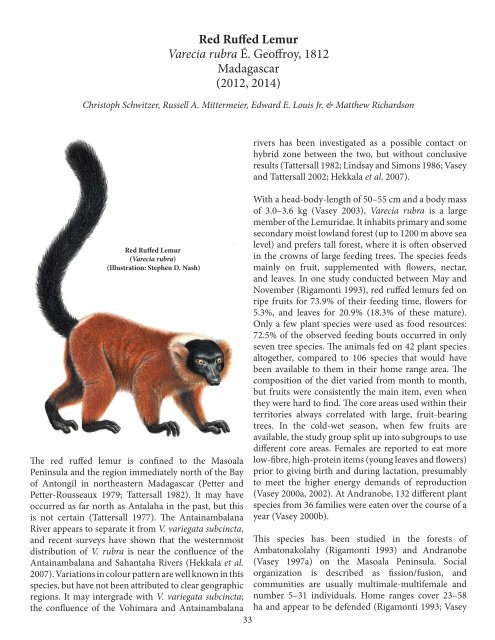Primates in Peril
f12q6x
f12q6x
You also want an ePaper? Increase the reach of your titles
YUMPU automatically turns print PDFs into web optimized ePapers that Google loves.
Red Ruffed Lemur<br />
Varecia rubra É. Geoffroy, 1812<br />
Madagascar<br />
(2012, 2014)<br />
Christoph Schwitzer, Russell A. Mittermeier, Edward E. Louis Jr. & Matthew Richardson<br />
Red Ruffed Lemur<br />
(Varecia rubra)<br />
(Illustration: Stephen D. Nash)<br />
rivers has been <strong>in</strong>vestigated as a possible contact or<br />
hybrid zone between the two, but without conclusive<br />
results (Tattersall 1982; L<strong>in</strong>dsay and Simons 1986; Vasey<br />
and Tattersall 2002; Hekkala et al. 2007).<br />
With a head-body-length of 50–55 cm and a body mass<br />
of 3.0–3.6 kg (Vasey 2003), Varecia rubra is a large<br />
member of the Lemuridae. It <strong>in</strong>habits primary and some<br />
secondary moist lowland forest (up to 1200 m above sea<br />
level) and prefers tall forest, where it is often observed<br />
<strong>in</strong> the crowns of large feed<strong>in</strong>g trees. The species feeds<br />
ma<strong>in</strong>ly on fruit, supplemented with flowers, nectar,<br />
and leaves. In one study conducted between May and<br />
November (Rigamonti 1993), red ruffed lemurs fed on<br />
ripe fruits for 73.9% of their feed<strong>in</strong>g time, flowers for<br />
5.3%, and leaves for 20.9% (18.3% of these mature).<br />
Only a few plant species were used as food resources:<br />
72.5% of the observed feed<strong>in</strong>g bouts occurred <strong>in</strong> only<br />
seven tree species. The animals fed on 42 plant species<br />
altogether, compared to 106 species that would have<br />
been available to them <strong>in</strong> their home range area. The<br />
composition of the diet varied from month to month,<br />
but fruits were consistently the ma<strong>in</strong> item, even when<br />
they were hard to f<strong>in</strong>d. The core areas used with<strong>in</strong> their<br />
territories always correlated with large, fruit-bear<strong>in</strong>g<br />
trees. In the cold-wet season, when few fruits are<br />
available, the study group split up <strong>in</strong>to subgroups to use<br />
different core areas. Females are reported to eat more<br />
low-fibre, high-prote<strong>in</strong> items (young leaves and flowers)<br />
prior to giv<strong>in</strong>g birth and dur<strong>in</strong>g lactation, presumably<br />
to meet the higher energy demands of reproduction<br />
(Vasey 2000a, 2002). At Andranobe, 132 different plant<br />
species from 36 families were eaten over the course of a<br />
year (Vasey 2000b).<br />
The red ruffed lemur is conf<strong>in</strong>ed to the Masoala<br />
Pen<strong>in</strong>sula and the region immediately north of the Bay<br />
of Antongil <strong>in</strong> northeastern Madagascar (Petter and<br />
Petter-Rousseaux 1979; Tattersall 1982). It may have<br />
occurred as far north as Antalaha <strong>in</strong> the past, but this<br />
is not certa<strong>in</strong> (Tattersall 1977). The Anta<strong>in</strong>ambalana<br />
River appears to separate it from V. variegata subc<strong>in</strong>cta,<br />
and recent surveys have shown that the westernmost This species has been studied <strong>in</strong> the forests of<br />
distribution of V. rubra is near the confluence of the Ambatonakolahy (Rigamonti 1993) and Andranobe<br />
Anta<strong>in</strong>ambalana and Sahantaha Rivers (Hekkala et al. (Vasey 1997a) on the Masoala Pen<strong>in</strong>sula. Social<br />
2007). Variations <strong>in</strong> colour pattern are well known <strong>in</strong> this organization is described as fission/fusion, and<br />
species, but have not been attributed to clear geographic communities are usually multimale-multifemale and<br />
regions. It may <strong>in</strong>tergrade with V. variegata subc<strong>in</strong>cta; number 5–31 <strong>in</strong>dividuals. Home ranges cover 23–58<br />
the confluence of the Vohimara and Anta<strong>in</strong>ambalana ha and appear to be defended (Rigamonti 1993; Vasey<br />
33


